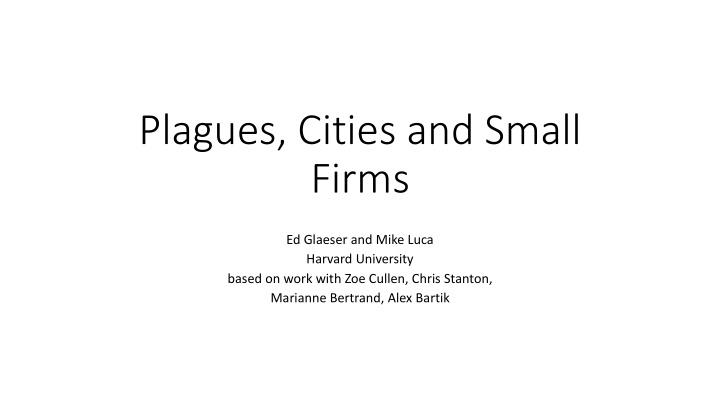



Plagues, Cities and Small Firms Ed Glaeser and Mike Luca Harvard University based on work with Zoe Cullen, Chris Stanton, Marianne Bertrand, Alex Bartik
A Staggering Economic Dislocation
Farm to Factory to Urban Service Workers: to Extreme Pandemic Vulnerability
Helping the small business landscape • What is the current small business landscape? • How might the ecosystem evolve in the coming months? • Are there policies or approaches to help small businesses better navigate the crisis? • Today: discuss two surveys focused on these questions.
How Are Small Businesses Adjusting to COVID-19? Early Evidence from a Survey Alex Bartik, Marianne Bertrand, Zoe Cullen, Ed Glaeser, Mike Luca, and Chris Stanton
First survey sent through Alignable: Network of Small Businesses (March 26-April 3)
Broad geographic coverage
Payroll per employee
Closure Rates by Size Mean Mean SD Currently Current v Jan Closed Employment Under 5 0.46 0.66 0.49 5-9 0.47 0.52 0.45 10-19 0.41 0.55 0.47 20-99 0.36 0.58 0.42 100-499 0.26 0.72 0.44 Total 0.45 0.60 0.45 N 4969 4362
Likelihood of Remaining Open by Dec 31st, 2020: Industry and Hypothetical COVID Disruption Duration Industry N 1 Month 4 Months 6 Months Professional Services 271 0.79 0.63 0.54 Health care 449 0.79 0.47 0.35 Banking/finance 177 0.78 0.63 0.59 Other 1,462 0.76 0.48 0.38 Real Estate 147 0.74 0.56 0.56 Construction 448 0.72 0.43 0.45 Restaurant/Bar/Cater 173 0.72 0.30 0.15 ing All Retailers, except 598 0.69 0.35 0.33 Grocery Tourism/Lodging 174 0.66 0.48 0.27 Arts and 314 0.65 0.45 0.35 entertainment Personal Services 214 0.57 0.40 0.22 Total 4,427 0.72 0.47 0.38
Closure Status and Source of Disruption N Supply Chain Employee Health Demand/Orders Currently open 2,198 30.3 49.8 66.2 Temp. closed 1,783 35.6 59.8 83.3 Perm. closed 85 37.9 60.8 86.1 Total 4,066 34.6 56.8 78.5
Cash available, by typical monthly expenses
How long do businesses think disruptions will last?
How do beliefs about COVID affect business decisions?
High level of interest in PPP • Nearly 75% expressed interest in federal aid. • However, some concerns about implementation.
Nine Takeaways from the Survey • The current landscape: • Almost half of these businesses were closed. • Closures were more common in smaller firms and retail firms. • Many small businesses are financially fragile – with little cash on hand. • The months to come: • Many do not anticipate being open in December. • The firms with less cash are less optimistic about surviving. • Few think that they can survive if the crisis lasts four or six months. • Navigating the crisis: • Policy can help - enthusiasm for public lending programs. • But some concerns about the implementation of new policies. • Varying expectations about length of crisis.
The evolving work from home landscape: Survey of NABE members • Survey of business economists. • Skews toward larger companies; e.g. nearly 40% at companies with 1,000 + employees. • Survey explores impact of COVID, and also adjustments to work setup. • Focus on the ability to work from home.
Four findings on working from home 1. Pre-COVID, considerable variation in remote work patterns. • Nearly 40% of respondents worked in companies where the vast majority of people did not work remotely; nearly another 30% worked in companies where the vast majority of people did work remotely. 2. Many people who could work from home chose not to. 3. COVID has led to a dramatic spike in remote work. Productivity effects not yet clear. 4. Roughly 40% of respondents expect remote work to be more common at their companies even after the crisis ends.
Thank you
Recommend
More recommend